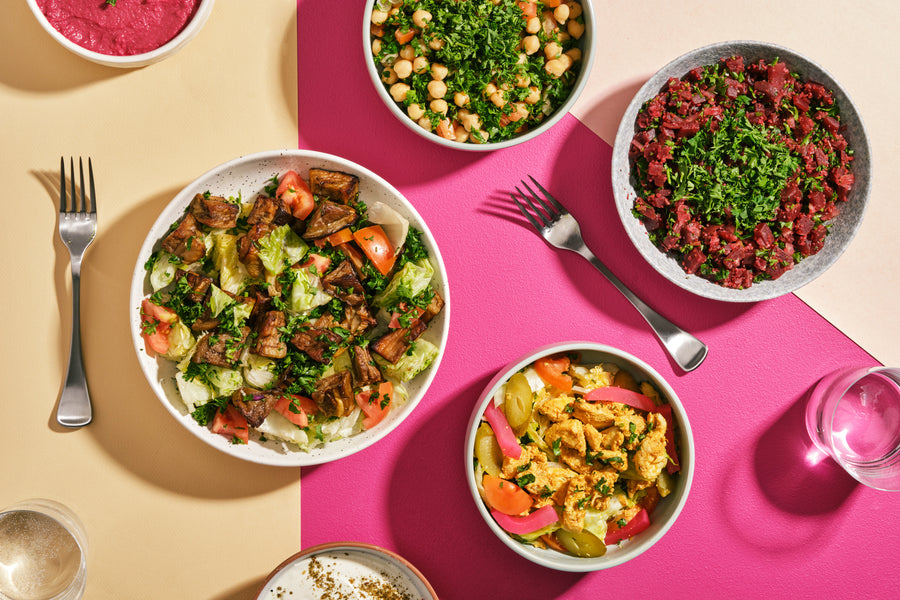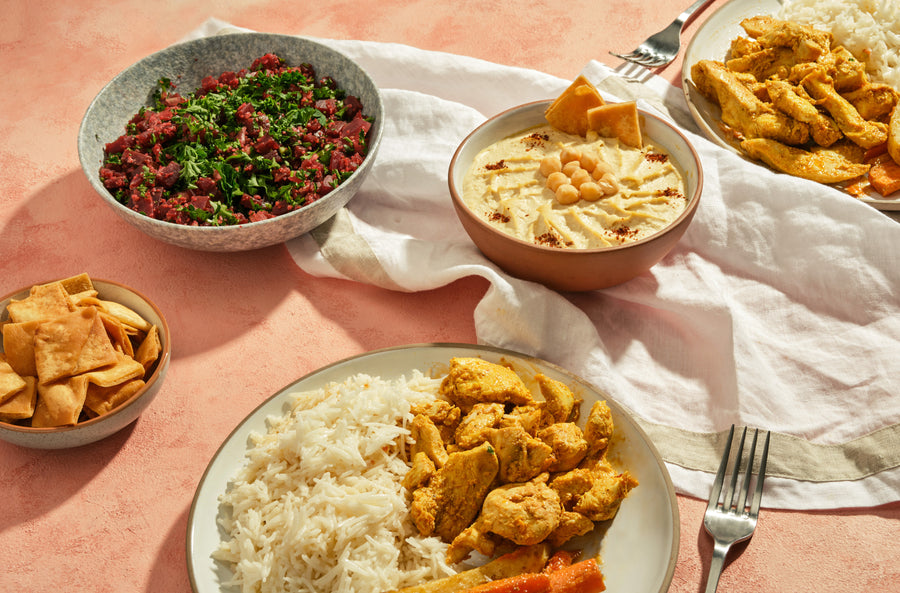A Deep Study Syrian Cuisine: Understanding Its Cultural Importance and Halal Aspects
Syrian cuisine embodies a rich tapestry of historic narratives and social influences. Each recipe narrates of neighborhood and custom, highlighting the significance of shared meals. The adherence to halal practices not only mirrors religious ideas yet likewise shapes the identification of Syrian food preparation. As international events challenge these cooking customs, the resilience of this cuisine remains a centerpiece of social preservation. What lies behind the flavors that define this enduring heritage?
The Historic Origins of Syrian Cuisine
Syrian cuisine has actually evolved over centuries, its historic roots are deeply linked with the region's varied social influences. Positioned at the crossroads of numerous human beings, Syria has absorbed culinary practices from the Phoenicians, Greeks, Romans, and Ottomans, amongst others. This rich tapestry of background has contributed to a food identified by a blend of flavors, spices, and food preparation strategies. The fertile lands of the region have actually likewise played a vital function, offering a wealth of grains, fruits, and vegetables that create the foundation of several recipes. The introduction of brand-new ingredients via profession and conquest further enhanced the culinary landscape, enabling the development of one-of-a-kind regional specialties. Furthermore, the influence of surrounding countries has actually led to a vibrant exchange of culinary ideas, solidifying Syria's setting as a substantial gamer in the more comprehensive context of Middle Eastern gastronomy.

Typical Syrian Meals and Their Cultural Relevance
Standard Syrian meals are not just cooking staples but also lug deep cultural importance, reflecting the nation's rich heritage. Iconic meals, often prepared throughout joyful occasions, work as a way of unifying areas and households. These meals personify the tastes of Syria while strengthening social bonds with shared customs and parties.
Iconic Syrian Staples
When exploring the abundant tapestry of Syrian cuisine, one discovers a variety of famous meals that not only entice the taste buds but likewise personify the nation's social heritage. Among these staples, Kabsa stands apart as an aromatic rice dish, frequently seasoned with seasonings like saffron and cardamom, signifying hospitality. Fattoush, a lively salad made with blended greens and crispy bread, shows the relevance of fresh active ingredients in Syrian food preparation. Muhammara, a spicy dip made from walnuts and peppers, showcases the rich tastes particular of the area. Furthermore, Kibbeh, a dish made from bulgur and minced meat, is commonly considered a nationwide prize, standing for public events. Each recipe tells a story, connecting individuals to their origins and traditions.
Festive Meal Customs
Syrian joyful dish customs are abundant with meaning and relevance, as households collect to celebrate important celebrations via the sharing of cherished dishes. Dishes often display a selection of traditional foods, with dishes like mansaf, tabbouleh, and kibbeh taking center stage. Each dish lugs social history; as an example, kibbeh, made from bulgur and minced meat, represents friendliness and abundance. During Ramadan and Eid, households prepare special sweets such as maamoul, representing happiness and unity. These gatherings foster area bonds, as sharing a meal symbolizes love and togetherness. The preparation and satisfaction of these meals show Syria's diverse cooking heritage, linking family members customs and local influences, consequently enriching the joyful experience and protecting social identification.
The Role of Family Members and Neighborhood in Syrian Food Culture
Food acts as an essential thread that weaves together household and community in Syrian culture. Meals are usually public experiences, where households gather around a table to share traditional dishes that show their heritage. The preparation of food is a public activity, with generations working side by side, passing down dishes and cooking methods. This practice strengthens familial bonds and fosters a sense of belonging within the community.Special occasions and religious parties additionally highlight the value of food in Syrian culture. During these occasions, family members prepare intricate dishes that offer not just to nourish but likewise to express love and hospitality. The act of sharing food represents unity and assistance among good friends and next-door neighbors, reinforcing social ties. With these shared cooking experiences, Syrians cultivate a strong identification rooted in their rich social history, showing exactly how food goes beyond plain nutrition to become a crucial part of their social textile.
Halal Practices in Syrian Cooking
In the context of public dishes and household gatherings, halal practices play a substantial function in Syrian cooking. These techniques originate from Islamic dietary laws, guaranteeing that food is prepared and eaten in a manner that straightens with faiths. For numerous Syrian households, adherence to halal concepts affects numerous elements of dish prep work, from sourcing active ingredients to cooking methods.Animals made use of for meat should be butchered according to details standards, emphasizing humane therapy and conjuring up the name of Allah. Furthermore, cross-contamination with non-halal products is meticulously avoided in both home kitchen areas and commercial establishments.This dedication to halal not just shows spiritual commitment however likewise promotes a feeling of area, as family members commonly collaborated to share meals that honor these customs - Brunch Kitsilano Vancouver BC. Subsequently, halal techniques are deeply woven right into the fabric of Syrian cooking culture, forming both daily life and festive celebrations
Ingredients That Specify Syrian Flavors

The essence of Syrian cuisine is shaped by a harmonious mix of vital seasonings and natural herbs that enhance its distinct flavors. Typical cooking strategies additionally elevate these components, showcasing the abundant cooking heritage of the region. A review of important ingredients exposes the foundational function they play in producing authentic Syrian recipes.
Secret Flavors and Herbs
A dynamic tapestry of flavors characterizes Syrian food, with key flavors and herbs playing a vital role in specifying its significance. Noticeable amongst these are coriander, cumin, and sumac, which lend depth and heat to different dishes. Cumin, with its nutty fragrance, usually enhances stews and smoked meats, while coriander adds a citrusy note to salads and dips. Sumac, understood for its tangy flavor, lightens up recipes and is frequently sprayed over fattoush or kebabs. In addition, cinnamon and allspice supply a subtle sweet taste, typically discovered in both wonderful and full-flavored preparations. Fresh natural herbs like parsley, mint, and dill are additionally essential, providing a burst of freshness and stabilizing the abundant, complicated flavors that make Syrian cuisine special.
Conventional Food Preparation Methods
Cooking strategies in Syrian cuisine show a deep-rooted tradition that improves Continued the tastes of its components. Approaches such as slow-cooking and braising are generally used, permitting herbs and flavors to combine beautifully with meats and veggies. Cooking, specifically over charcoal, gives a smoky richness to dishes like kebabs, while steaming is typically made use of for rice, preserving its appearance and taste. Furthermore, sautéing is favored for preparing fragrant bases, typically beginning with onions and garlic to construct deepness. Fermentation contributes in producing distinct tastes, evident in meals like pickled veggies. These strategies not only highlight the high quality of active ingredients yet also embody the common spirit of page cooking, bringing family members with each other around shared dishes steeped in custom.
Necessary Components Introduction
While checking out Syrian cuisine, one rapidly discovers that important ingredients play a crucial duty in specifying its unique tastes. Olive oil, a staple, gives splendor and depth, commonly working as a base for lots of dishes. Fresh natural herbs, such as mint, cilantro, and parsley, add lively scents and preferences, improving the general experience (Brunch Kitsilano Vancouver BC). Seasonings like cumin, coriander, and cinnamon are regularly used, adding warmth and complexity to meals. In addition, Syrian food greatly integrates grains, particularly bulgur and rice, which function as fundamental components in various recipes. Pulses, especially chickpeas and lentils, use both nourishment and texture. Together, these ingredients develop the harmonious balance that identifies Syrian meals, reflecting the country's rich cooking heritage and cultural significance
The Influence of War on Syrian Culinary Practices
The battle in Syria has functioned devastation throughout the country, its effect on cooking traditions reveals a complicated interplay of resilience and adaptation. As communities faced variation, conventional recipes were modified due to the shortage of components and sources. Family members usually rely upon locally offered fruit and vegetables, incorporating new flavors and techniques into their dishes, which brought about the emergence of special analyses of timeless dishes.Moreover, the war cultivated a spirit of uniformity among displaced cooks and home chefs, that shared their cooking expertise through social media and neighborhood cooking areas. This sharing of recipes not only maintained cultural heritage but likewise produced a feeling of belonging among those impacted by the problem. Regardless of the challenges, the interest for food remains a unifying force, permitting individuals to maintain their identification and connect with their roots, also in expatriation. As a result, Syrian cuisine remains to evolve amidst adversity, reflecting both an abundant history and contemporary resilience.
Frequently Asked Inquiries
What Prevail Food Preparation Techniques Made Use Of in Syrian Cuisine?
Common food preparation methods in Syrian food consist of barbecuing, cooking, sautéing, and stewing. These approaches boost flavors and structures, permitting the creation of diverse dishes that reflect the region's rich culinary heritage and traditions.
Exactly How Has Globalization Influenced Syrian Food?

Exist Vegetarian Options in Conventional Syrian Recipes?
Vegan choices prevail in standard Syrian recipes, including active ingredients like vegetables, lentils, and chickpeas. Popular dishes such as Mujadara and Falafel emphasize this diversity, accommodating various dietary choices while maintaining the abundant flavors of the food.
What Beverages Pair Well With Syrian Dishes?
Beverages that match well with Syrian meals view it now consist of mint tea, pomegranate juice, and ayran - Brunch Kitsilano Vancouver BC. These drinks complement the tastes of traditional dishes, boosting the dining experience while giving invigorating contrasts to the abundant, mouthwatering tastes
Just How Do Syrians Commemorate Food During Holidays or Festivals?
Syrians commemorate food during vacations and celebrations with fancy banquets, usually featuring typical meals. Family events emphasize sharing dishes, signifying unity and cultural heritage, while special treats and sugary foods highlight the cheery spirit and common pleasure. Typical Syrian meals are not only culinary staples yet likewise bring deep social importance, mirroring the country's abundant heritage. When discovering the abundant tapestry of Syrian cuisine, one discovers a variety of renowned dishes that not only entice the taste buds yet likewise personify the country's social heritage. Syrian cheery meal practices are abundant with meaning and significance, as family members gather to commemorate important events through the sharing of beloved recipes. Food preparation techniques in Syrian cuisine mirror a deep-rooted custom that improves the tastes of its active ingredients. Vegetarian options are prevalent in standard Syrian meals, featuring components like chickpeas, vegetables, and lentils.